Some years ago a very kind person gave me an edition of a reprinted Missale Romanum supposed to be the 1962 edition. It even has 1962 printed on the cover, as the photo shows here.
This is NOT an edition of the 1962 Missal.
If you have this or just bought it, DON’T PANIC.
“But Father! But Father!” you may be saying, as sweat breaks out on your forehead. “The cover says 1962! Surely you’re wrong about this. It must be the 1962 edition! That’s what I paid for!”
Au contraire, my sweaty friend. But, again, do not panic. You have not bought a useless book.
“But Father! But Father! &%$^#!!”, you continue. “How do I know that the edition I have is really a 1962 edition?”
Many of you will have old editions of the Missale Romanum. Very few of you will actually have a 1962 edition. In that case, to use it at all, first, you will have to make sure you are following the rubrics established by John XXIII in 1960 and tweaked in 1962.
The fastest way to see if your edition is really a 1962 edition is to check the Roman Canon to see if the name of St. Joseph is included. This was a change made by Bl. Pope John XXIII for the 1962 edition. St. Joseph’s name was not in the Canon before the 1962 edition. Not even in the 1960 edition, which is picture above despite the bold “1962” on the cover.
Here is a photo of the page of the Roman Canon in this supposedly “1962” reprint editon pictured above. Notice that St. Joseph’s name is not there. I marked the spot where it should be.
To find out what edition you actually have, you can look at the “legal” documents at the beginning of any Missal. A Missal always includes the texts of the documents which promulgate the edition. Remember, back in the day publishing houses were given permission by the Holy See to print liturgical books. So, the publication date of an edition printed in the USA might actually be after the year of the edition.
In the reprint edition in question here, you can see that this is NOT the 1962 edition of the Missal by checking the documents. Here are shots of the documents in the supposedly “1962” edition that interest us.
Here is the General Decree of promulgation Novum rubricarum dated 1960. This tells you that what is decreed in John XXIII’s Rubricarum instructum of 1960, which made all sorts of changes the rubrics, is duly promulgated and that the new rubrics went into force on 1 January 1961. It also talks about the Breviary and Martyrology, but they don’t interest us here.
It is small, but you can see the date is 1960. I circled it.
Here is the other document, Pope John XXIII’s Rubricarum Instructum which made all the significant changes to the rubrics of the Mass. Click on it for a larger image.
The date is clearly 1960.
“But Father! Bu…” Yes, I know. What is the difference?
First, the documents. In an edition of the 1962 Missal, this is the document you would find. This is the Decree Novo rubricarum corpore of
The 1962 typical edition will have the two documents I included above. But it will also include this, which shows that it is the “typical” edition, that is, it is the edition to which all subsequent editions and approved reprints must conform.
Why is this important? After all, you can simply write in the name of St. Joseph between the lines pretty easily. And, the rubrical changes such as the removal of the so-called “Second Confiteor” occured with John XXIII’s document of 1960 called Rubricarum instructum (pictured above).
I think people ought to know what they are getting. What is advertised is the 1962 edition. That is not what you get. You get something very similar, but it isn’t the 1962 edition.
On a side note, in the chapel of The Sabine Farm, I use a 1962 Missal, in an edition called the “editio prima iuxta typicam“, the first edition printed according to the typical edition. It was printed in Italy for a Spanish publisher, probably for use in Latin American countries. I imagine it was distributed to missions and dioceses straight from Rome by the organization that had it made.
In order to reprint the 1962 typical the publisher had to have permission of the Holy See. So, here you find not the decree that what you have in your hands is the very typical edition itself, but rather a different decree saying that what you have in your hands conforms exactly to the 1962 typical edition. Here is the decree.
You can see that this is the according to the 1962 book. And sure enough, unlike the 1960 edition (on sale with the cover I showed you at the top of this entry) in the hallowed pages of this edition I use in The Sabine Chapel, you find the name of St. Joseph in the Roman Canon. This is what it looks like.
So, older Missals can be used, but you have to be aware that changes need to be made if they are editions before 1962. Whatever book you use, the 1962 edition’s rubrics and calendar are permitted, not those of earlier editions.
You can double check what you are doing in the useful 1962 edition, a reprint, of Fortescue and O’Connell The Ceremonies of the Roman Rite Described, (hard to get right now, I think) which has a page of helpful corrections at the beginning. Also, the new edition of Trimeloni is useful, if you know Italian and can get it.
Caveat emptor!
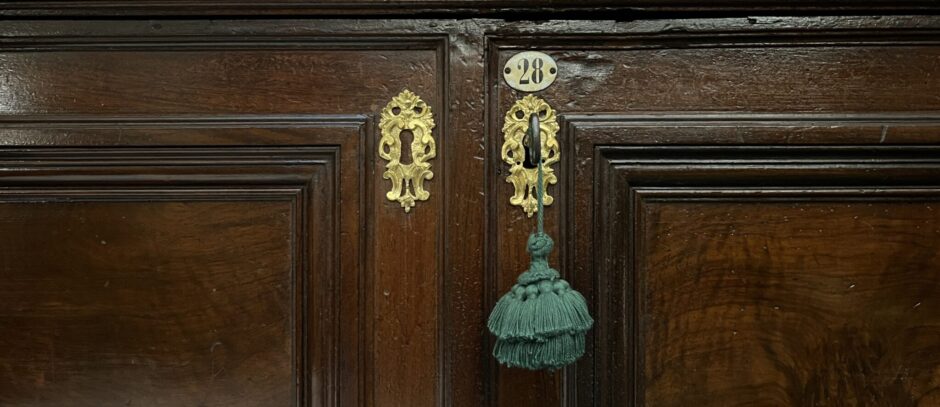
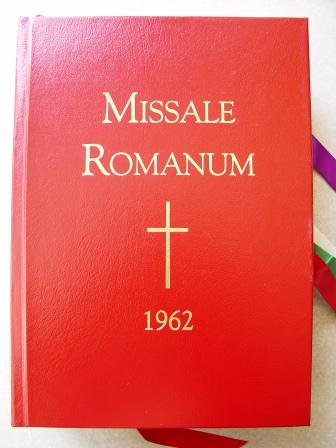
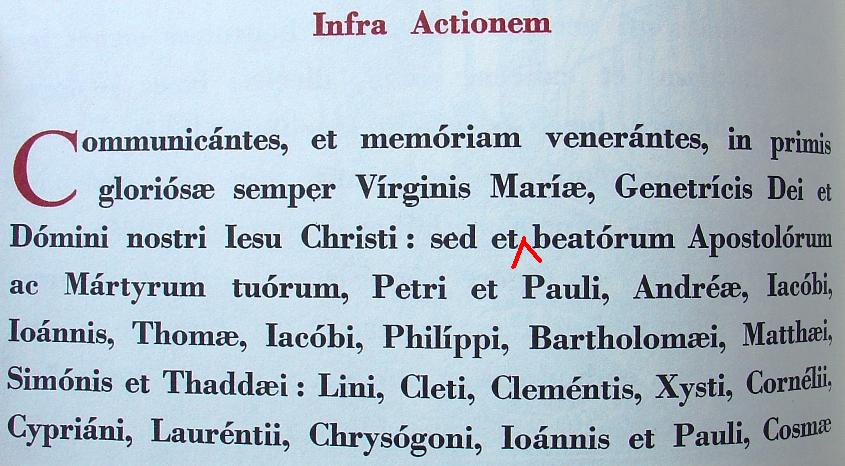
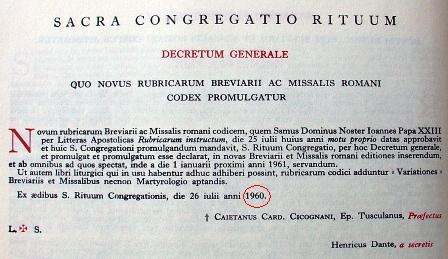
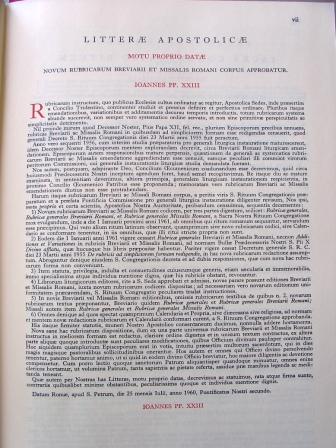
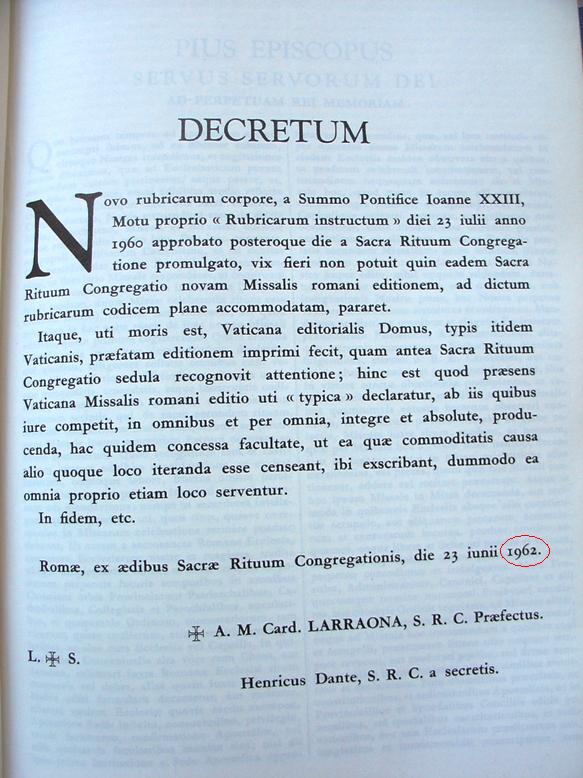
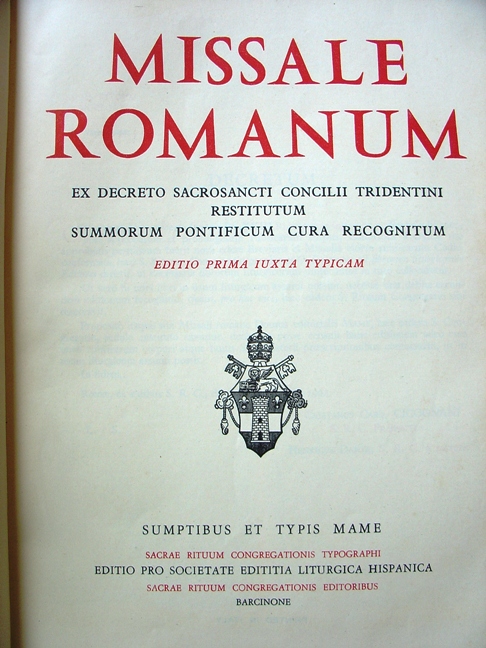
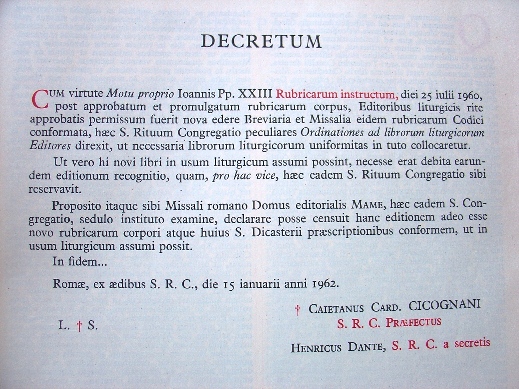
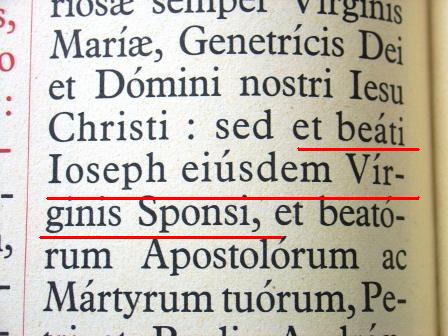

































Thank you Father for this subtle and illuminating explanation. I will check my Missale Romanum when I am next home.
This is fascinating, Father. Has anyone compiled lists of the changes between the editions from 1570 through 1962? That would be some really interesting reading. I actually have a copy of Andrew Hughes Late Medieval Liturgical Offices (searchable here), which initially got me interested in studying lectionaries, in a roundabout way. Anyhow, I’m sure it would be much easier to have compiled all the changes/differences since these are only a relatively few printed editions, not thousands of manuscripts.
In addition, would you know of a similar work covering the three editions of the Novus Ordo?
I guess I’m liturgically curious today!
Thank you Father for this subtle and illuminating explanation. I will check my Missale Romanum when I am next home. If I am not mistaken, I think it was printed AFTER 1962 (maybe 1964), but it ‘appears’ to conform to the 1962 missal, but I will check.
Thank you Father for this subtle and illuminating explanation. I will check my Missale Romanum when I am next home. If I am not mistaken, I think it was printed AFTER 1962 (maybe 1964), but it ‘appears’ to conform to the 1962 missal, but I will check.
Or maybe a severe case of hiccups?
Father,
Love the site and the very informative insight that you have.
The caveat that you provided is true, but there is also a correction. Included with the Missal which is pictured at the top is a small sticker which makes the correction which you noted about the insertion of St. Joseph into the Canon. So, while the text is actually the 1960 version, it is very easily correctable to the 1962 version.
(I should know, I have that very same edition siting less than ten feet to my right!)
(Now if I just knew how to use it!)
One a side note, having that edition available answered a question on some interest to the Cathedral in Cincinnati, where I currently reside. The anniversary of the Dedication of the Cathedral is celebrated on November 3rd, but it was actually dedicated on November 2, All Soul’s Day. In the current calendar, this would not happen, but was permissible in the older calendar. Things that make you go ‘Hmm…..’
I have one of that edition, purchased new, recently. They have a sticker to put over the part of the Canon to add St. Joseph.
And sure enough, unlike the 1960 edition (on sale with the cover I showed you at the top of this entry) in the hallowed pages of this edition I use in The Sabine Chapel, you find the name of St. Joseph in the Roman Canon.
Indeed each copy of the afore-mentioned 1960/”1962″ Missale Romanum that I have gladly purchased for each priest I’ve found interested in learning the TLM — and will continue to purchase for each additional such priest I personally uncover — has come with a pre-printed paste-in insert to include St. Joseph in the Communicantes.
Father,
Speaking of rubrics and such, is it permissible for a layman to make sets of altar cards? Must they have an Imprimatur to be used?
So, I have a couple of important questions:
1) Where can we obtain an authentic 1962 Missal?
2) If we do have the 1960 Missal with the 1962 cover, what are the specific differences besides Saint Joseph being inserted into the Canon (which was provided as an insert with the Missal)? Because I noticed that the Good Friday liturgy in this Missal does not have the controversial “incredulous Jews” line (which I thought was only changed in the 1962 Missal).
There is also an edition of the “1962” (this is a Benziger edition) with a final fascicle bound in the very back – actually AFTER – some of the blank pages, and imprimatured (oddly) on October 10, 1962 (since by the next day, His Eminence should have been at St. Peter’s for the opening session of Vatican II), with the four so-called “Gallican” Prefaces:
Preface of Advent
Preface of the Most Blessed Sacrament
Preface of the Dedication of a Church
Preface of All Saints/Patronal Saints
While the Dedication Preface and All Saints ended up in the post-Vatican II Missale Romanum (at least in an adapted form), neither of the two current Advent Prefaces is the one that appeared in this final edition of the Missale Romanum 1962, nor is the Most Blessed Sacrament Preface one of the two with that title in the post-Vatican II Missale Romanum. The loss of this “Gallican” Blessed Sacrament Preface is especially sad, since it employs the imagery of the animal sacrifices of the Old Testament being “shadows” now done away with by the perfect Sacrifice that has come in Christ, thoughts beautifully set forth by the Holy Father in JESUS OF NAZARETH.
Oh, well, you scholarly people, I’m confused. It seems there are only two “1962” Missals available right now, one by Baronius Press and one by Angelus Press. I have the latter, which has ‘1962’ in gold emblazoned on the cover, but not on the inner pages like in these pictures, and nothing about St. Joseph. Anyone know if the Baronius edition is REALLY 1962? I thought both were the same.
‘”But Father! But Father! &%$^#!!”, you continue.’
Classic.
Several months ago I purchased a nicely-produced little volume with the following on the title page: “The Daily Missal and Liturgical Manual with Vespers for Sundays and Feasts From the Editio Typica of the Roman Missal and Breviary, 1962,” etc.
It is from Baronius Press, and does contain the reference to St. Joseph as discussed. It does not contain the prefatory documents described with the 1962 date, but does make it clear that it has been fully revised and updated.
It is a wonderful volume, and includes material at the front which summarizes Catholic teaching in a way I have never found before. It also contains the Gallican Prefaces and supplements for additional Masses for England and Wales, Scotland and the United States.
For a whopping $52.00 plus Minnesota’s state tax and Uncle Sam’s share, it’s a value at twice the price!
I’ll certainly be anxious to see if Liturgical Press, Liturgy Training Publications, Catholic Book Publishing, GIA, OCP or WLP decide to take the “real” version to press first!
Several months ago I purchased a nicely-produced little personal missal with the following on the title page: “The Daily Missal and Liturgical Manual with Vespers for Sundays and Feasts From the Editio Typica of the Roman Missal and Breviary, 1962,” etc.
It is from Baronius Press, and does contain the reference to St. Joseph as discussed. It does not contain the prefatory documents described with the 1962 date, but does make it clear that it has been fully revised and updated.
It is a wonderful volume, and includes material at the front which summarizes Catholic teaching in a way I have never found before. It also contains the Gallican Prefaces and supplements for additional Masses for England and Wales, Scotland and the United States.
For a whopping $52.00 plus Uncle Sam’s share, it’s a value at twice the price!
Along with the good Roman Sacristan I ask, “Where can we obtain an authentic 1962 Missal?”
It would be wonderful if Midwest Theological Forum would/could print one as fine as their N.O. Missale Romanum.
Pater, OSB
Along with the good Roman Sacristan I ask, “Where can we obtain an authentic 1962 Missal?”
It would be wonderful if Midwest Theological Forum would/could print one as fine as their N.O. Missale Romanum.
Pater, OSB
Anne writes:
Oh, well, you scholarly people, I’m confused. It seems there are only two “1962†Missals available right now, one by Baronius Press and one by Angelus Press. I have the latter, which has ‘1962’ in gold emblazoned on the cover, but not on the inner pages like in these pictures, and nothing about St. Joseph. Anyone know if the Baronius edition is REALLY 1962? I thought both were the same.
Father Z’s post is about altar missals (and I think I know the one to which he is referring) — what a priest would use at the altar — not handmissals — what the laity would use — such as the Angelus Press missal and the Baronius Press missal. The Angelus and Baronius missals are both in line with the 1962 Missal, no need to be concerned about that. I’ve heard good things about both (though I tend personally not to use a handmissal at all).
Anne,
Yes, the nearly identical Angelus and Baronius missals are REALLY “1962 compliant” (St. Joseph and all) Latin-English HAND missals (for individual pew use). For instance, on pages 886-887 of your 1962 Angelus missal, under the “Invocation of the Saints” you see the words “as also of blessed Joseph, her spouse” (sed et beati Joseph, ejusdem Virginis Sponsi) which Blessed John XXIII added to the Canon, and which (I understand) constitute the only difference between 1960 and 1962 at the hand missal level.
By contrast, the missals Fr. Z is discussing are (Latin only) ALTAR missals for official liturgical use by the priest-celebrant.
I understand that Baronius Press will be producing a “new” 1962 Missal, complete wtih the Motu Proprio and Bishops’ Letter in September of this year. It will bear the “nhil obstadt” and “imprimatur” of the Bishop of Lincoln, Nebraska. The Baronius Press website has details, but it is a complete reprint, as I understand it, fully in accordance with the Motu Proprio, fully “kosher” and in accordance with the MP. About $55, US, I think….
The loss of this “Gallican†Blessed Sacrament Preface is especially sad, since it employs the imagery of the animal sacrifices of the Old Testament being “shadows†now done away with by the perfect Sacrifice that has come in Christ, thoughts beautifully set forth by the Holy Father in JESUS OF NAZARETH.
Yes this is a truly deep and wonderful preface, and thankfully it’s not really lost, since it’s still available for ad libitum use by the celebrant. For instance these Gallican prefaces are printed for such use in the FSSP Ordo.
Yes, here’s the Baronius Press link:
http://www.baroniuspress.com/book.php?wid=56&bid=4
On another topic, every time I’ve read your blog, I notice that we from the Commonwealth and residents of the USA, are, in Churchill’s words, “divided by a common language”. Why is it that we call our Bishops “Your Lordship”, our Archbishops “Your Grace” and our Cardinals “Your Eminence”? “Your Excellency” is reserved for Viceroys…..
Fr, My church has two Missals which have on the copyright page some stuff copyrighted ’62 and other stuff copyrighted ’64. Would this be a ’62 missal? (looking at it i thought it had alot too much english in it, but i dont know how much english a Missal should have in it.)
DCS, David & Henry Edwards:
Thank you for good info! I’m learning, and Fr. Z’s blog is a tremendous help.
The requirement to include St Joseph in the canon took effect on 8th December 1962. I`m a bit confused. If the typical edition dates to June 1962 would it not then be one without the name of St Joseph in the canon?
This was the edition reproduced in the 1990s as the T.M. movement was really gaining alot of momentum. If I remember correctly, Latin Mass magazine had a hand in it and Cardinal O’Conner authorized its publication in the wake of a large-scale and very hyped up mass that Cardinal Stickler offered at St. Patrick’s Cathedral in NYC. It is not a perfect 1962 edition but its availablility has served the Church well. (Though I do think that it is shamefully expensive.)
I hope that the necessary books are reprinted ASAP with beautiful art in them, not the usual cubist figures. Also, if there are editions ‘reprinted’ I hope that they are reproduced well because sometimes those editions look like someone just ran them off at the office copier. Until then, I can remember to say St. Joseph’s name.
I wonder (just out of curiosity) why Father Z. seems to be giving great importance to the name of St. Joseph as part of the Canon, but when he was talking about the use of the biretta, shoes with bucklesm, etc…, a while ago, he just basically said that people should not worry if they do not see them done/worn even at Masses using the 1962 Missal?
Could it be just a personal preference?
latinmass: Father Z. seems to be giving great importance to the name of St. Joseph as part of the Canon, but when he was talking about the use of the biretta, shoes with bucklesm, etc…, a while ago, he just basically said that people should not worry
That’s because those things are mere frippery compared to the texts of Mass.
Kevin P. Edgecomb: You can find a comparison of the missals of 1570, 1939, 1956, 1962, and 1970 here: http://www.ordorecitandi.com/ Click on Liturgical Changes in the upper right corner. To find Holy Week, then click on March and scroll down. It is interesting, indeed.
I just received delivery from allcatholicbooks through Amazon.com (155.00) of a missal that looks exactly like the one on the blog. it includes the letter of Card. O’Connor and a copy of the apprporiate decree and a nicely printed “stickum” for the place in the canon for St. Joseph.
does that cover the problem?
I just received delivery from allcatholicbooks through Amazon.com (155.00) of a missal that looks exactly like the one on the blog. it includes the letter of Card. O’Connor and a copy of the apprporiate decree and a nicely printed “stickum” for the place in the canon for St. Joseph.
does that cover the problem?
Unfortunately the St Joseph sticker is only large enough to go over one of the special communicantes and not over the part that is most frequently read – at least that’s how it is in the copy of the missal that someone gave me for a gift
CBM, that is the same one I got. Given it used to be around $300 USD, the markdown is great, assuming the Canon text (which is provided as an insert) is the only difference.
However, shouldn’t the Libreria Editrice Vaticana be pumping out altar versions of things by now?
It seems odd that the pope just released a major liturgical document and I can’t find anything but a study edition (useless for the altar) on their website at paxbooks.com.
Is this one of those conspiracies that other groups in the Holy See are preventing the pope from getting things done? ;)
As a post script, I certainly don’t see the USCCB jumping at the opportunity to help publish an authentic 1962 Missal.
CBM: I’d think it covers the problem. Yours is the same one I’ve gotten for several priests. Given the size and beauty of this altar missal (and being in the book business myself), $155 seems a good price for it; I paid $310 for the first one I bought some time ago (perhaps about the same time as Roman Sacristan). But the price is still falling as they sell like hot cakes in the wake of the motu proprio. I just checked and saw that allcatholicbooks.com has lowered the price to $124. Let’s hope the supply lasts long enough to sustain the restoration.
Roman Sacristan: As a post script, I certainly don’t see the USCCB jumping at the opportunity to help publish an authentic 1962 Missal.
Why not? What better way to carry out their appointed and sworn duties to promote the Faith and spread the Gospel as chief Evangelists and successors to the Apostles. Seriously, if I bore the weight of their responsibilities and observed the difference in faith and devotion between typical ordinary and traditional communities, I’d surely waste no time in doing everything I could to increase interest in the extraordinary form of the Mass (whatever were my purely personal liturgical preferences).
Henry Edwards: if I bore the weight of their responsibilities …
I’d do the same thing too, if I bore the weight of their responsibilities, but I don’t think they will.
Aren’t they still “considering” Summorum Pontificum or forming a committee to “look into it”? As if they have some say in whether it actually applies to the U.S.?
As you can see, I’m rather disappointed with several bishops’ negative response to Summorum Pontificum.
http://romansacristan.blogspot.com/2007/08/scripture-still-relevant.html
:)
I have a 1962 daily missal published by “Catholic Book Publishing Co.”, New York. Edited by Fr. H. Hoever S.O.Cist., Ph.D. which includes the reference to Saint Joseph in the canon. Is a Latin-Spanish version. I inhereted it from my grandparents. How would I have known that this exact version would be restored for use in my lifetime. Incredible don’t you think? I don’t think that in the country where I live you can find this.
It includes the notation that this is a “New Edition in complete accord with the New Code of Rubrics for the Mass.”
The missal is entitled Saint Joseph Daily Missal” with publishing date of 1962 by Catholic Book Publishing Co. N.Y., printed in the U.S.A.
Thank you, FranzJosf, that’s fascinating!
Father Bartoloma: I hope that the necessary books are reprinted ASAP with beautiful art in them, not the usual cubist figures
Leave the cubist figures alone Father. They are the only nostalgia I have!
Interesting. I just looked again at the envelope that came along with the “1962” Missale Romanum from Roman Catholic Books, and it had not only the insert for adding Saint Joseph into the Canon, but as a sparate sheet comes the second “Decretum” which Father shows in the pictures above and is dated 1962. However, liked I said, it isn’t in the book, but is included along with the Saint Joseph insert.
“But Father, but Father” I say … I am confused.